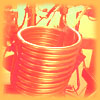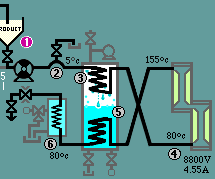
![]()

![]()
© 1998-2005
Raztek Corp.
![]()
top of page
![]()
top of page

![]() This section introduces you to our technologies by offering a basic explanation of each
technology and how it works. Subsequent sections delve into more technical
explanations of our major focus on Electroheating™ and Rapid Cooling technologies.
This section introduces you to our technologies by offering a basic explanation of each
technology and how it works. Subsequent sections delve into more technical
explanations of our major focus on Electroheating™ and Rapid Cooling technologies.
 
|
What does it do for me?
Whether your product is food or biotech, you can improve operating profits and product quality through Raztek’s Electroheating™ technology. Electroheating™ offers a much faster heating rate than traditional heating, with heating time as short as a fraction of a second. It is applicable to both fluid products and particulates in an appropriate fluid medium. It allows heating to temperatures beyond the abilities of standard heat exchangers without coagulation or fouling of the equipment. This method can rapidly kill microorganisms and viruses without affecting the sensory, nutritional, or functional properties of the product.
How does it work?
Electroheating™ works by passing an alternating electrical current through a fluid food or
biotech product, creating electrical resistance heating in the material.
What does it do for me?
The Rapid Cooler gives cooling rates near that of flash cooling of a product without the
loss of water and volatile components from the product. This cooling process can also act
as a heat regeneration system if the cooling medium used for condensation is a cold
product that needs to be heated. This system can be used to regenerate up to 80% of the
heat added to a product. It can also be used for rapid chilling in one step, if the
condenser is fed by a cold fluid flowing at higher rate than that of the product.
How does it work?
Rapid cooling works by taking advantage of the high rate of heat exchange during
vaporization and condensation of a fluid under vacuum. By passing hot product through a tube that is
exposed to a fluid under vacuum, the fluid is quickly boiled by extracting heat from the
product. At the same time, a cold material passed through a tube in the space above the
boiled liquid will extract heat from the vapors and cause them to condense and fall back
onto the hot tube below.
What does it do for me?
Convac technology allows items that have previously required batch processing in a vacuum
environment to now be processed on a continuous line without interruptions. By replacing
multiple batch systems with a single continuous system, great savings can be realized.
How does it work?
Material is introduced to a vacuum chamber through a multi-pocket wheel that is shielded
by a condensible gas. The particulated product (such as fruit) and condensible vapor
enter the chamber, where the vapor
is condensed. This prevents loss of vacuum. This process can be used for removal of
air from the tissue of the product, replacing the air with a liquid and even seal
containers under vacuum. This technology is useful for any product that needs to
enter and leave a vacuum chamber.
Quality Can Manufacturing
Raz
What does it do for me?
Raz treatment can transform tinplate that gives only fair enamel adhesion into tinplate
that consistently gives superior enamel adhesion.
Improved enamel adhesion will greatly increase canned goods shelf life and reduce
premature failure of the can. For some products that may peel enamel or cause underfilm
corrosion in a year or less,
the Raz treatment can more than double the cans’ expected lifespan.
How does it work?
Raz is a very short electrochemical treatment for tinplate prior to enameling. The anodic
treatment provides a very
uniform surface that has an affinity for good enamel
adhesion.
Atmocure
What does it do for me?
This technology allows extremely rapid curing of enameled steel products and recovery of
all the solvents
used in the enamel for recycling. By recovering the solvents, the manufacturer also
eliminates the need to incinerate the vapors that are normally released during the curing
operation. This also leads to a reduction in volatile organic compounds that create
pollution.
How does it work?
The freshly coated steel product is passed through an induction coil that
raises the temperature of the steel to about 250°C within one or two seconds.
The coating is rapidly polymerized and the solvents evaporated. A saturated solvent vapor atmosphere is maintained by preventing free air from entering the area
where enamel curing occurs. Under these conditions a very sharp boundary is maintained
between the solvent vapors and the air surrounding the curing area by means of simple
condensing coils. Excess solvent vapors that would overflow or leave the defined area are
condensed on the coils and collected for recycling. This prevents toxic fumes from
entering the workplace air supply and escaping into the surrounding environment. Emerging Technologies Water Research
![]()
Corrosion studies in the late 80's have led David Reznik to the development of a new understanding of the role of atomic hydrogen in corrosion mechanisms. As the source of the atomic hydrogen is water, Raztek launched a research on the biological oxidation-reduction reactions and the redox potential of water in general. Oxidation in the biological world is best defined as loss of atomic hydrogen and reduction is the gain of atomic hydrogen.
This research has led Raztek to the conclusion that the hydrogen species (H, H+, OH, OH- and also H-) have a qualitative dimension along with the known quantitative values. Hydrogen species in water absorb some energetic properties from the materials they are in contact with. Thus, hydrogen that originated from one antioxidant differs in some physical properties from hydrogen that originated from another antioxidant. This difference dictates which compounds the hydrogen atom would reacts with. Hydrogen atoms from vitamin C, for example, affect different systems than hydrogen atoms from vitamin A or E.
Generally speaking water in contact with materials could receive the information carried by the hydrogen species. This information may have the effect of the materials even though the material itself is not present. Water, then, serves as an active material, not just as a solvent or provider of mobility. This could explain the differences between water sources which share the same chemical composition: water quality is not determined by its chemistry alone, but also, and often more importantly so, by the physics of wave phenomena.
Raztek is researching the scientific basis of the above approach and develops applications of this theory in the fields of agriculture and the biotech and food industries.